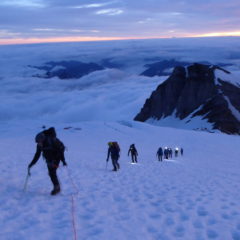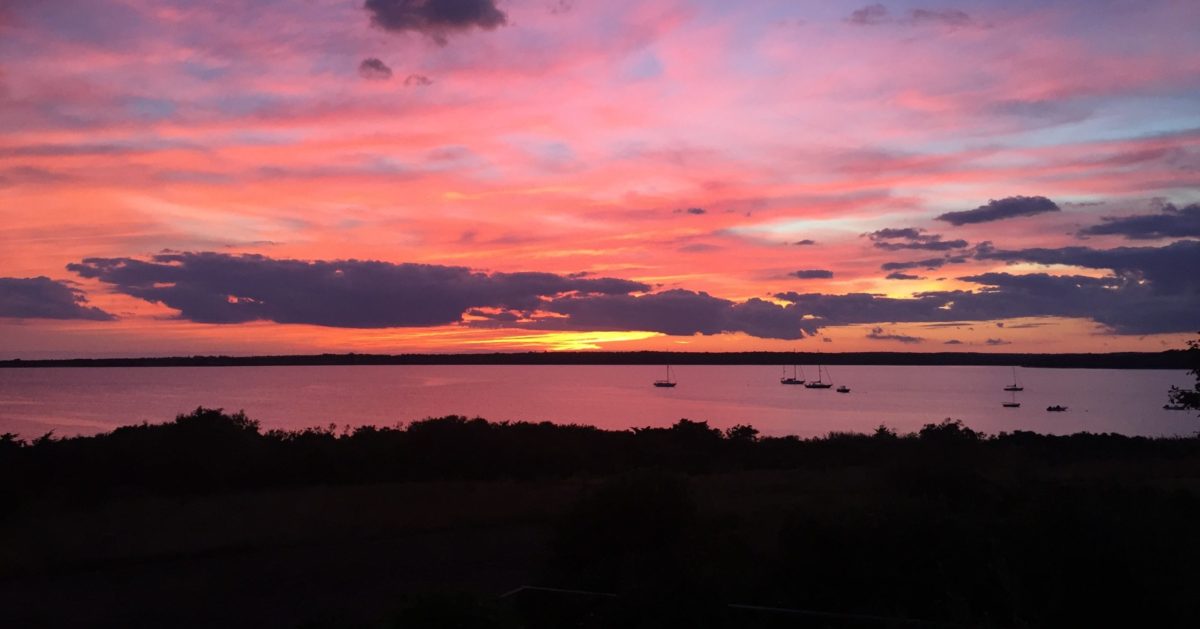Five months ago, I returned home after almost getting to the summit of Everest. In the weeks that followed, I reflected a lot on what “almost” meant. I felt great about the experience and was proud of how our team had performed. While I regretted that the weather prevented us from getting to the top, I had experienced much of what I went to the mountain seeking. I was home safely, could put the disruption to my family behind, and looked forward to returning to a more balanced daily life.
When people asked me “are you going back?”, my answer was consistent. I didn’t know for sure, but didn’t think so. During the two months I was in Nepal, every day except one had gone as hoped for. The one day that didn’t was due to forces beyond our control: the arrival of a second cyclone that made going for the summit out of the question. Decending the Lhotse Face safely in a blizzard was arguably more challenging than climbing the final stretch would have been. We had a lot to be proud of. While it was disappointing not to get to the top, my sense of self worth didn’t depend on it. The journey had been more important than the destination. At least that is how it felt in the initial weeks after the climb.
Of the many photos I took on Everest, one stuck in my mind. We are above Camp 3, heading into the so-called “death zone” to Camp 4 at 26,000 feet. Above us are the iconic features of the Yellow Band and Geneva Spur, which I had pictured in my mind since childhood and would shortly climb over. The sun was shining and the sky an intense blue. After a short stay at Camp 4, we would be leaving for the final climb to summit. The photo was in one of my last posts from the mountain. Here it is again:
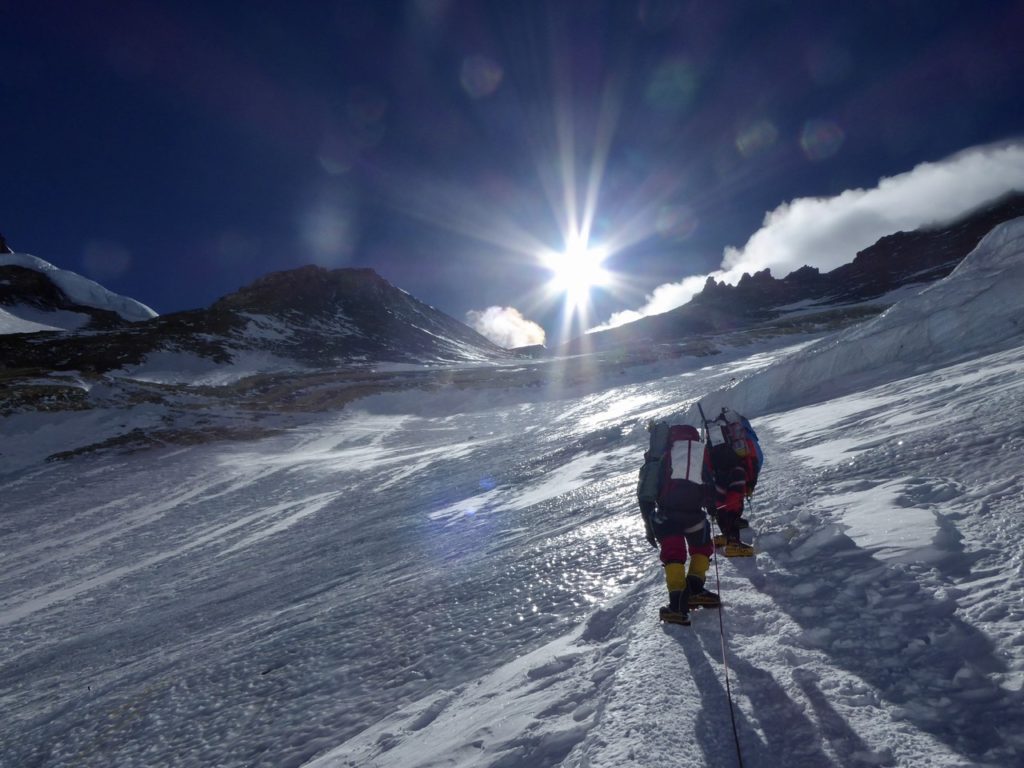
When I took this photo, every step was brutally hard. It had taken years of training and weeks of climbing to get there. I was moving upward into what felt like outer space, accomplishing something I had long dreamed of. Looking back, I can hardly believe I was there. We didn’t yet know that the clouds were about to move in, the snow would start, and it would be over a week before the skies cleared. After I returned home and reflected on the experience, I found I wasn’t ready to let it go. We had been so close. The phrase that kept popping into my head was “unfinished business”. I realized I wanted to give it one more shot.
The thing that broke it open was deciding to combine another try for the summit with a new life experience. At first, I got excited about climbing the mountain by a different route, on the north side. I researched how I could bicycle across the Tibetan plateau from Lhasa to base camp, something I would love to do. But then reality set in. With the continuing challenges of Covid, the probability that the Chinese authorities allow climbing on the north side of Everest this season is low, and the chance that their quarantine rules allow for biking to base camp are even lower. Like all of us, I am tired of having my plans disrupted by a virus and don’t want to subject myself to that again.
So this spring I am heading back to Nepal and the south side of Everest, with a twist. In place of the usual trek up the Khumbu Valley to base camp, I will fly into the Makalu-Barun region east of Everest, trek up to the base of Makalu, the fifth highest mountain in the world, climb over three 20,000 foot passes, and drop down into the Khumbu Valley south of Everest. Some good friends will join me on this adventure. They will then head back the US, and I will head up to Everest base camp to join my climbing team.
I have wanted to do the Makalu “three passes” trek ever since a college friend did it over thirty years ago and shared his photos from this remote part of Nepal. Here is one of them, which has long been on the bulletin board above my desk. It shows some of the passes and glaciers we will cross as we hike and climb from the Makalu-Barun region to the Everest region.
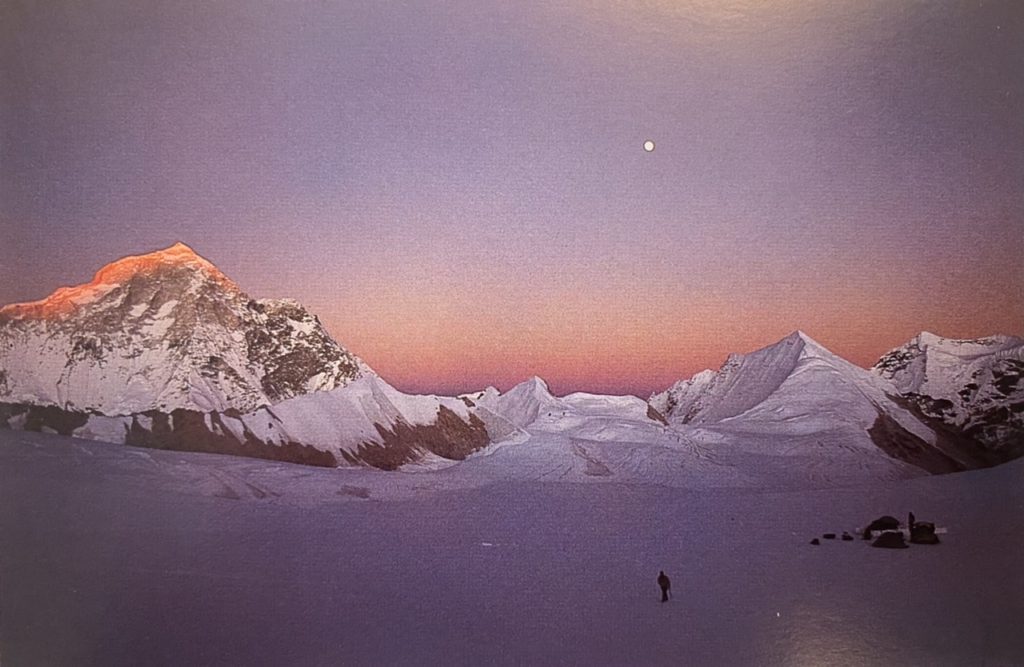
Photo credit: Peter Forbes
For over three decades, I have looked at this photo and thought “I want to go there”. Now I am going. And when I get over those passes, I will get one more shot at climbing to the top of the world. While Everest remains my main focus, and I need to make sure I don’t over-extend myself on the trek, I am really excited about all of it.
It took me until the end of July to realize I wanted to head back, but it wasn’t a final decision until I got Jill’s blessing. This was an uncomfortable request, and I kept finding excuses to put it off. When I finally raised it, she listened carefully as I hemmed and hawed, and responded: “I knew you were going back.” Then she said something that reflects her depth of character, and for which I am eternally grateful: “You let me be me. I have to let you be you”.
Re-engaging the gears
For me, the best test of a decision is how it feels with the passage of time. This one is feeling right. Mountain climbing is not a fully rational act. For whatever reason, there is profound satisfaction in getting to a highest point. Summits are summits. Dreams are powerful. Just as it was deeply meaningful to climb over long pictured landmarks like the Yellow Band and the Geneva Spur, there are features on Everest’s summit ridge about which I feel the same way. It remains to be seen if I will climb over them this spring, but I am getting another chance.
There is also the wonderful structure that comes with pursuing a goal, and the joy that comes from outdoor exercise. After returning from Everest, I spent the remainder of June gaining back the 15 pounds I lost while on the mountain. In July, I did some easy runs with an eye toward restoring my base conditioning. Then in August, having decided to return to the mountain, I cranked up the training. Now, every morning I wake up with a workout to do, sometimes two. I am back doing long runs in the woods, roller ski outings on country roads, mountain hikes with heavy packs, and strength routines in my version of an at-home gym. It is sometimes hard to get going, but always feels great when I am done.
I will be returning to Everest with a different climbing group. This is not out of dissatisfaction with how thing turned out previously. Our expedition last spring was a strong team that I really liked, led by world class guides. Our “go late” strategy was one I explicitly sought. With 20-20 hindsight, had we gone earlier we would have in all likelihood summited, but no one could have foreseen the two cyclones in a row that hit the mountain. Ben made good decisions with the information he had. A few teams actually ended up waiting out the second cyclone and got to the summit in the very final days of the climbing season, but they climbed through heavy post cyclone snow and a level of avalanche hazard that we would have been uncomfortable with. Mountaineering is a lot about calculated assessment of risk/return. I have no regrets about the choices we made.
One notable difference about our group this spring is that we will pursue a two-rotation model rather than three. In other words, rather than making two trips through the icefall onto the upper mountain and then back down to base camp before launching our final summit push, (as we did this past spring), we will make only one round trip prior to our summit push. This will reduce the total number of trips through the icefall from six to four, (two up and two down, rather than three up and three down), and also reduce overall wear and tear on our bodies. The offsetting con is that we will spend less time up high acclimatizing . Based on how my body performed at altitude last spring, I think I can handle it. And time spent this spring on the Makalu-Barun trek, where I will spend multiple days between 18,000- 20,000 feet, should also help my acclimatization.
Recent hikes and climbs
Turning to current activities, past readers of this blog will recall my Everest tent mate Thomas, a great person and strong climber who ended up having difficulties in the death zone, resulting in a challenging descent down the Lhotse face. Last month, Thomas and I met in Lake Placid and did one of his favorite hikes, the so-called Great Range Traverse. The traverse is legendary: 22 miles across eight of the highest peaks in the Adirondacks, involving 11,000 feet of elevation gain. Thomas told me about it while we were on Everest, and we had agreed to do it together someday.
The plan was to complete the traverse in a single day. We started in the dark at 5:00am and finished in the dark at 8:00pm. In between, we climbed up and down steep trails, got our boots covered in mud, and looked out over vistas of vibrant October colors. It was simultaneously exhausting and exhilarating, and gave us time to reflect on our experience together on Everest. Here is a photo of Thomas late in the afternoon approaching the summit of Mount Marcy, the highest peak in New York State:
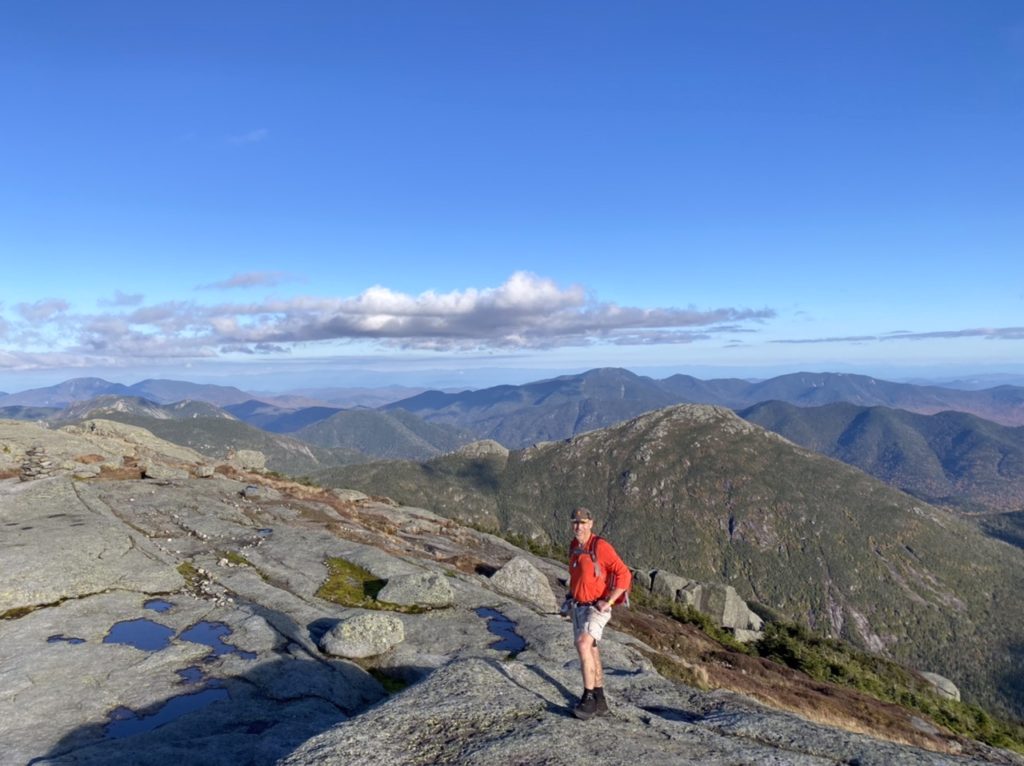
I have also been doing lots of hikes in the White Mountains, loaded up with a heavy pack for training purposes. These are welcome opportunities to get into the high country, and great ways to spend time with friends. Here are a couple of recent photos.
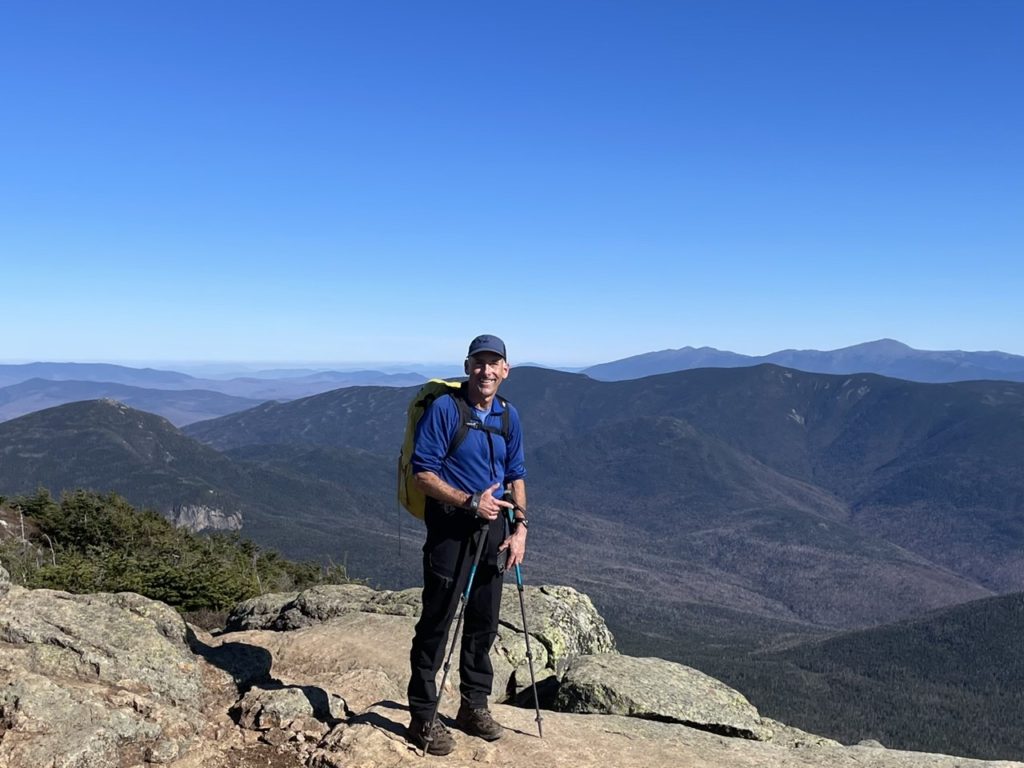
Franconia Ridge, credit Brad Brown 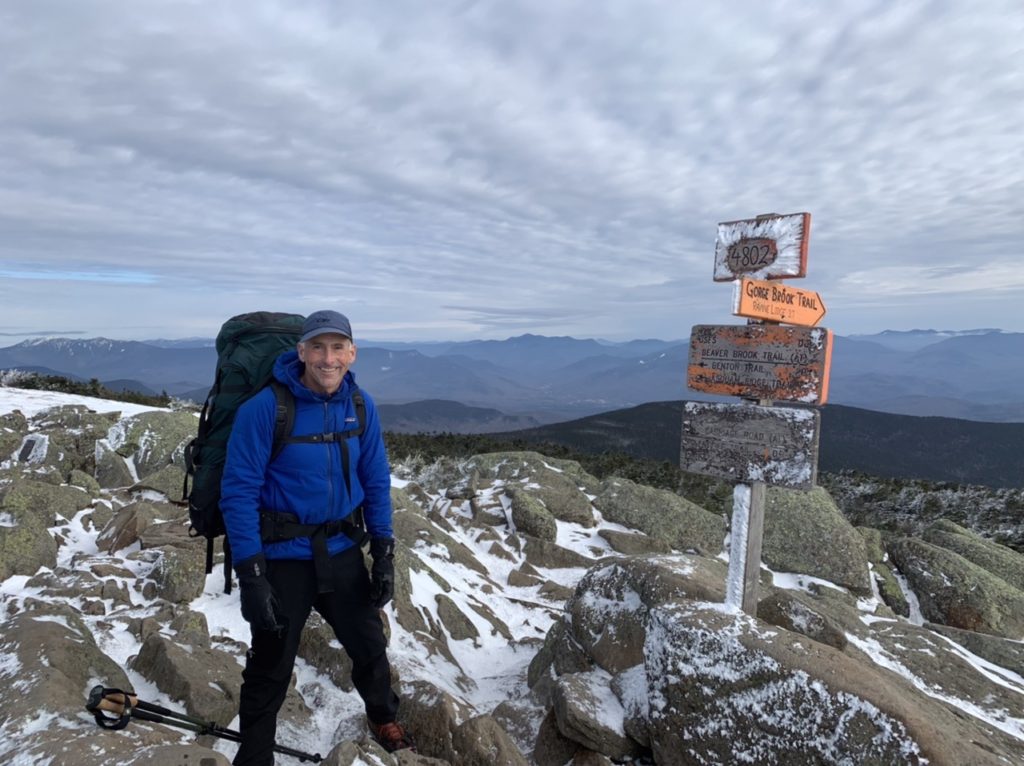
Moosilauke, credit Graham Schelter
While I could be doing all of this training and hiking without returning to Everest, I don’t think I would be. Goals are wonderful forcing mechanisms, paying huge dividends in life structure and meaning. Having doubled down on the destination of Everest’s summit, I have been granted another year of a great journey.
In that vein, I leave next week for Ecuador, where I will join Mark Pattison in climbing Cotopaxi, a 19,300 foot volcano. Mark and I climbed together in Antarctica in 2019 and have remained friends. He was also on Everest this past spring, climbing with a group that hung tough high on the mountain during the first cyclone and managed to summit just before the second one arrived. A couple of hours after I took the photo at the top of this post, as we climbed to Camp 4, Mark passed us on the fixed lines as he was descending to Camp 2. He was physically battered, to the extent that I almost didn’t recognize him, and was focusing all of his remaining energy on getting down safely. After our summit bid was thwarted, he sent me a thoughtful note:
“My heart aches for you. I wish you would have joined our expedition from the start. It’s water under the bridge at this point but I felt so aligned with you. Timing was everything and we just got a super lucky window for one day. I big time struggled but got her done. I ended up climbing by myself and could have used your companionship to help me up there. Are you going back?”
Mark has an interesting life story, which has a lot to do with the power of goals in adding meaning to life. A recent documentary does a good job of telling it. For those of you who like mountaineering films and have thirty minutes to spare, google “Searching for the Summit Mark Pattison YouTube“, locate the 28:58 length film by the NFL Network, and see what you think. The Everest footage is from when we were both on the mountain.
Mark turned to mountaineering after a career in football. Having now achieved his goal of climbing all of the Seven Summits, he is sorting out what comes next. His near term goal is to celebrate his 60th birthday on top of Cotopaxi. I look forward to standing by his side. In typical Mark fashion, he says he wants to do 60 push-ups on the summit. I told him I will film every one of them.
What about the blog?
So I think I will fire up the blog again, although in somewhat different form. Less frequent posts through the winter. Then, after flying to Nepal in late March, I’ll try to provide an update or two on the trek, followed by more frequent posts from Everest itself. If you would like to be taken off the list that receives notifications, by all means let me know. Similarly, if you know someone who would like to be added, just send me their email.
Meanwhile, I hope you all had great Thanksgivings. Amid the inevitable ups and downs, we have so much to be grateful for.
